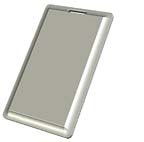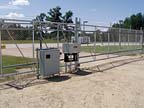
For the physical security industry, RFID is particularly useful for access control applications. RFID technology can be found in contactless smart cards or proximity cards, which communicate with RFID transponders through radio waves. While the technology has been used in the industry for several decades, RFID-based systems have traditionally been classified as a higher-end application than systems such as Weigand or magnetic stripe. Experts predict a boom in the commercial and retail markets for RFID technology, but security applications and RFID technology will continue to grow, as well. Many experts agree that an increased demand for RFID will drive lower prices and technological improvements, making RFID-based systems more commonplace in the physical security market.
The Growth of RFID
“In the long term, everything will be tagged. We see physical security being the cornerstone for RFID technology,†says Allan Griebenow, president and chief executive officer of Axcess International Inc., Dallas. “As tags become more feature-rich, cheaper and smaller, everything will be tagged – from human resources to assets for automatically improving the organization,†he adds.RFID costs have decreased and many believe that interest from the commercial or retail markets are driving down costs and boosting technology – and will continue to do so.
RFID-based systems are nothing new for access control applications. The lower maintenance costs associated with a contactless system are seen as convenient, even though the initial total cost for an RFID system may be higher. Users do not have to remove an RFID card from their purse or wallet, for example. Systems such as magnetic stripe involve physically inserting a card into a reader, causing long-term wear and tear on both the cards and the readers.
Yet, 10 years ago, the cost of an RFID-based access control system was still too costly for many companies to implement. “Now, with so many other uses, the cost is very competitive,†emphasizes Jerry Cordasco, vice president and general manager Compass Technologies, Exton, Pa., a manufacturer of access control and alarm monitoring software and hardware.
Because of convenience and improving technology and capabilities, some manufacturers are pushing to phase out non-RFID-based systems and only replace broken readers or new cards for existing access control applications. According to Bob Holland, senior product marketing manager with HID Corp., Irvine, Calif., prices for RFID systems have continued to come down steadily over the years. “It’s not expensive if you’ve got something worth protecting,†Holland emphasizes.
According to the “Security Industry Annual Report 2004†by Lehman Brothers, proximity cards based on RFID are slowly replacing magnetic, Weigand, bar code and barrier ferrite cards. “Over time, RFID readers will take over completely,†Cordasco agrees. “It won’t happen overnight because those people that have a heavy investment in mag stripe won’t want to replace all readers,†he adds.
Holland says that the replacement is happening quickly, not slowly, and RFID-based applications are the most economical choice for access control. “You can get magnetic stripe for cheaper, but it can be erased easily, scratched, or left in the heat, which causes the stripe to curl or break off,†Holland says. While HID Corp. has a magnetic stripe line and Weigand line, sales are only to existing customers, he says.
Angelina Lopez, marketing communications for HID Corp., adds that to help customers switch existing access control systems to RFID-based systems, the company manufactures multiple technology or multi-technology cards, which allow companies to keep their older readers until they break down. “This helps with the migration,†she says. “Customers can keep using the same readers and swap them out as they grow and as budgets permit.â€
In addition to the benefit of contactless cards, RFID-based systems have the ability to hold more information than other technologies. For example, biometric data can be linked with RFID-based systems. “It’s not your everyday usage, because there are not that many people using biometrics, but it’s used,†Cordasco says.
RFID systems also can be linked with video security systems. “Systems can link cameras and access control systems such that if you come to a reader with your card, the operator will see your picture come up from a database and compare it to your live picture that was switched on from the reader,†Holland explains. Linking video and access control are good ideas for night applications, he says. “A camera can pan-tilt-zoom and also link the access control transaction history with camera data to look at events triggered in the systems.â€
“RFID is a broad spectrum that crosses beyond the security business,†Cordasco says. He believes large companies in the supply chain management sectors are driving improvements in RFID. “RFID’s use for other industries is pushing developments in the technology. That has driven cost down and had people focus on it now,†he says.
Aside from cross-industry interest in RFID technology, some in the security industry believe that mandates, such as those in hospital, military or government applications will cause a growth in RFID technology for the industry. “It’s a combination of mandates, plus the ability and necessity to provide greater security,†Griebenow says about projected growth of RFID in the security industry. According to a study by The Freedonia Group Inc., the market size for RFID is expected to nearly triple each year to the year 2012.
Mike Guillory, principal of Strategic Action Consulting Services, Hickory Creek, Texas, believes that government interest in the technology will cause growth – a growth he believes will be moderate. “There is already a demonstrated track record for using the technology. There will be growth because of concerns by the government and organizations where security is high priority. Mandates will drive it where cost doesn’t justify it,†Guillory says.
Guillory doesn’t buy into the notion that retail and commercial interests will ultimately fuel growth of RFID in the security industry. “The retail sector has different requirements than what physical security needs,†Guillory says. “They want low cost and a unique identifier for supply chain. They are less concerned about the security of the item – they are not trying to protect commodity paper goods,†he says. “I think the visibility of the retail market has increased interest by providers, but I don’t think that will be the primary course to drive down costs.†Mandates will dictate greater use of the technology, more than cross-industry interest, according to Guillory.
There are still applications, however, where RFID-based systems may not be the best choice. “What we see is a tendency for users with a high turnover rate to stick with simple magnetic stripe cards. They don’t turn to proximity because of the cost issue,†Cordasco says. An example would be colleges or universities where large numbers of students graduate and enroll each year, he says. If costs continue to decrease and capabilities increase, then this might change.
New Potential Application: First Response
One application with plenty of room for growth, according to Cordasco, is emergency response. By keeping track of individuals in a building with RFID tags, first responders would be able to figure out who was still in a building and where they were, in the case of a fire, for example. “It’s easy enough with the software to even provide attributes for that particular person – for instance, find out if that person has a medical condition. We are pushing for much better response in an emergency based on location,†Cordasco says.John Baker, national sales manager RF Logics Inc., Torrance, Calif., agrees that this use of RFID could grow in the next few years. “That technology is here already,†Baker says of RFID in emergency response applications. “It may be within the next five years that places have more of that,†he predicts.
The read-write capability of RFID-based systems is another area that could become a larger trend in the future. While simple RFID technology used is one-directional or read-only, which means tags can be written once and read many times, two-directional communication is possible with RFID. “Write means the reader can actually write data and transmit that data to the card,†Cordasco explains. With read-write capability, information can be added to the tag or written over previous information when in range of a reader. While he doesn’t see much use for this technology in the present, there could be endless possibilities for this in the future.
Some manufacturers offer RFID for vehicle tracking and perimeter security applications. Nedap, Netherlands, manufactures active RFID systems to protect garages and building perimeters. “A lot of RFID applications have been building-oriented,†says Gorm Tuxen, exclusive agent for Nedap. “It’s equally important to secure the perimeter and know what vehicles are on your premises.â€
Nedap AVI’s systems make it possible to identify both the vehicle and passenger, and allow access to a perimeter without the passenger ever exiting the vehicle. “With RFID, you can manage access to your perimeter without a vehicle coming to a full stop – that’s a lot more secure way to allow people to enter your facility," Tuxen says.
In an effort to make Nedap’s RFID products compatible with prevailing market standards, Tuxen says the company offers systems that operate on more than one frequency. Therefore, users need only carry one card for both perimeter and building access.
Baker says that vehicle access control and tracking, along with other asset tracking such as laptop computers, is becoming more common in RFID-based security applications. “Technology will continue to improve and become more commonplace,†Baker says of RFID. While he thinks retail and airport applications are some of the biggest investors in the technology currently, Baker says that increased affordability and improved technology should spur a growth in all RFID markets.

Standardization
Some existing RFID systems use proprietary technology, making it difficult to switch to another vendor without replacing expensive equipment. Many experts point to lack of standards as one reason RFID in the security industry has not grown as fast as it could. Yet organizations such as the International Organization for Standardization (ISO) and EPCglobal have been working on providing RFID standardizations across all industries.“Standardization, yes, is an issue. There are different frequencies and different kinds of technology and not all are compatible, so this is a problem,†Cordasco says.
Cordasco expects that mandates and pressure from Homeland Security and other organizations pushing for standardization will accelerate the process.
“Because the government is trying to make a common access card that works between different agencies and branches of the military, they have been pushing real hard for a common technology and interoperability,†Holland says.
There are international standards that have been adopted for specific RFID applications such as animal tracking and smart card use. ISO/IEC 18000 includes a standard for supply chain use with high-frequency tags and ultra-high frequency tags. EPCglobal, an organization with its own standards process, has submitted its protocols to ISO, so that they may become international standards for all industries.
Guillory believes that standards are underway, and this is positive news for RFID technology in general. “I think people like to think it’s an issue. Any technology is best applied in the industry when it is generally available for multiple sources and interoperability. EPC submitted their standard to ISO, and ISO is in the process of amending ISO/IEC 18000 to accommodate the technical definition,†Guillory says. He adds that ISO is expected to finalize the amendment of the standard sometime in the beginning of 2006.
Standardization is expected to go hand-in-hand with market adoption. If prices continue to drop, technology continues to improve and applications continue to increase, the electronic security industry could find many more places to utilize RFID technology in the future.

Sidebar: What is RFID?
Radio Frequency Identification (RFID) is technology used to store and retrieve data using devices such as tags and transponders. An RFID tag is made up of a microchip that is connected to an antenna, which enables the tag to receive and respond to the radio waves from a transponder. Tags can be active or passive.
Differences between Passive and Active RFID
Active RFID tags have their own power source – usually a battery – for transmitting signals. Passive RFID tags do not have a battery for transmitting radio waves, but rather use the power created by the reader. The readers send electromagnetic waves, which induce a current in the tag’s antenna, and allow the tag to send waves back to the reader.
The typical read range for a passive tag is between 10 millimeters and 6 meters. Active tags can have much longer read ranges. Passive tags are more popular than active for everyday access control applications, because traditional access control applications generally would not need a read range of more than a foot, for example. Active tags typically are more powerful, because they contain their own power supply and tend to be more accurate and reliable.
“Passive will typically be lower cost, because you don’t have to have batteries. Modern technology today for the passive tag is a very simple structure from a material standpoint. Active systems might have higher performance, but cost more to produce,†says Mike Guillory, principal for Strategic Action Consulting Services, Hickory Creek, Texas.
However, Allan Griebenow, president and chief executive officer Axcess International Inc., Dallas, which manufactures active RFID systems, argues that the cost difference in implementing an active system over a passive one is not that different. He says that active readers can be less expensive than passive ones. “The end users have been focused on tag price. Customers need to look at the total cost, the ratio of tags to readers,†he says.
Dealers and integrators should work with their customers to determine the appropriate installation and application needs of each customer.

Sidebar 2: Electric Utility Company Employs Active RFID System
Active RFID tags have the benefit of typically working over a longer range than a passive RFID tag. An active RFID vehicle access control system reduces the times it takes for a vehicle to enter a gated area – one benefit of such a system. Axcess International Inc.’s active RFID vehicle access control system was recently implemented at Great River Energy, an electric utility company in Elk River, Minn., for automatically controlling vehicle access at its remote, secured locations. The system provides automatic identification and validation of authorized employees, tracks employee activity, and reduces the time it takes to enter gated areas.Before incorporating the access system, Great River Energy was using a manual lock and key system for gate access. “By installing Axcess’ access control system, we are able to automate entry into the facilities for authorized personnel and greatly enhance our security,†says Mark Royseth, instrumentation tech/electrician for Great River Energy.
The manual system involved getting out of the vehicle, opening the gate, then getting back in the vehicle and driving into the secure area. In addition to the automation that Axcess’ system provides, the security of getting out of the vehicle is also a concern for companies, says Allan Griebenow, president and chief executive officer Axcess.
Employees are provided with the active RFID key tag that transmits its unique user identification to a palm-sized receiver tied to the gate controller and authorized personnel are immediately provided access; the driver never leaves the vehicle. According to Royseth, another benefit of the new system is that Great River has an event log that automatically tracks employee activity at the company’s multiple locations.
The Axcess system can provide additional security by identifying the person inside of the vehicle, in addition to the vehicle. This way, the reader would need to verify both the vehicle and person wanting access, before access was granted. Griebenow adds that this additional security measure adds accountability to the system. “Just like in a building access control application, accountability is given to the individual employee rather than the car,†he emphasizes.